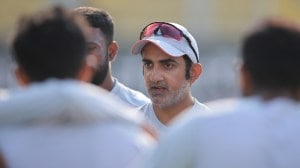How Delhi jeweller lost 22 kg in 2 years without weight loss pills: At 52, he ran for the first time. At 54, he’s an ace marathoner
On anti-obesity day, a transformation journey of a man who beat obesity and sleep apnea with diet, exercise and sleep discipline
 At 54, Manuvel Mezhukanal weighs 78 kg and has completed all of the world’s major marathons. (Special Arrangement)
At 54, Manuvel Mezhukanal weighs 78 kg and has completed all of the world’s major marathons. (Special Arrangement)Manuvel Mezhukanal had never run a kilometre in his life. But at age 52, he decided to run for his life. Literally, as he weighed 100 kg with all his blood parameters above normal range. At 54, he weighs 78 kg and has completed all of the world’s major marathons. “It has taken me two years to lose excess weight and the problems arising out of it. I began with baby steps but with severe lifestyle discipline, diet and exercise, all of it graded and supervised steadily, my parameters swung back to their normal range. I lost weight naturally without resorting to any kind of weight loss pills,” he says.
Manuvel’s story of body transformation shows how age-old routines for weight loss done at the right time and with persistence can yield results. “I always remind myself that I must stay off medication as long as I can. As I had to be given steroids during the Delta wave of Covid and had to go through its side effects, I was determined not to pump too many drugs into my body,” he says.
Once you are cleared for cardiac tolerance, have no risk factors and have built up your body rhythms from walking, then jogging, running can be the best way to challenge your body, says Dr Abhishek Srivastava, Director, Centre for Physical Medicine and Rehabilitation, Kokilaben Dhirubhai Ambani Hospital, Mumbai. “It elevates your heart rate, improves blood flow, delivers oxygen to your brain, muscles and organs more effectively and keeps your metabolism in fine fettle so that you can burn calories. Running is not just about cardio but a great way to lose weight, lower bad cholesterol, blood sugar and inflammation,” he says.
 Manuvel’s story of body transformation shows how age-old routines for weight loss done at the right time and with persistence can yield results. (Special Arrangement)
Manuvel’s story of body transformation shows how age-old routines for weight loss done at the right time and with persistence can yield results. (Special Arrangement)
Running in midlife is good for the body because it has the mechanical force necessary to stimulate the cells that build bone and inhibit the cells that take away bone. “Having healthy bone underneath the joint surface is particularly important for avoiding osteoarthritis,” says Dr Srivastava.
The beginning of a fitness journey
Manuvel worked hard to build his jewellery brand in Delhi and admits he was confined to a sedentary life for much of his early working life. “I would be at our store from 10 am to 8 pm, mostly sitting at a desk. I never realised that I was tipping over the scales till I had to consult a doctor in 2017. My snoring got worse and I developed sleep apnea (a condition where sleep is disrupted because of a blocked airway and relaxation of throat muscles). My condition worsened as I weighed 100 kg, so excess fat around the neck narrowed my airways even more. Abdominal fat restricted lung expansion,” he says.
Doctors suggested a breathing machine called CPAP, which forces air through the airways. But Manuvel refused to be strapped to a machine. His blood tests were not encouraging either. While a total cholesterol level less than 200 mg/dL is desirable, his was 250 mg/dL. While low-density lipoprotein or LDL (bad) cholesterol of less than 100 mg/dL is optimal, his had skyrocketed to 150 mg/dL. His high-density lipoprotein or HDL (“good”) cholesterol, which is cardio-protective, was below 30 mg/dL instead of the minimum 40 mg/dL. Triglycerides should be less than 150 mg/dL but Manuvel’s was 275 mg/dL. He was prescribed medicines.
“That was a wake-up call. The effect of medication would wear out if I did not lose body weight. That’s when I worked with a personal trainer who customised a gym routine for me and matched a diet that could go with it. Eating and exercising right, my weight reduced to 90 kg,” says Manuvel.
The Covid challenge
Covid was a testing time for Manuvel as he was hospitalised and suffered a severe side effect called footdrop, a condition where nerves, which control the muscles that lift the foot, are damaged. “I couldn’t even raise my leg and was put on steroids for 22 days. But since my condition did not improve greatly, I was advised steroids for another 15 days. Finally, I could regain 90 per cent use of my legs after physiotherapy. I felt wasted,” he says.
After his recovery, he signed up with functional fitness and running coach Gagan Arora. “In 2021, I had trouble running a kilometre. In 2022, I ran the Delhi half marathon, all of 21 km, as a pace runner, which means I set myself up to reach the finish line 30 seconds or so earlier than my goal time,” says Manuvel. He has paced up records ever since, completing a full marathon (42.2 km) in Berlin in 2023, the Tata marathon in Ladakh and till now has completed all world majors — New York, Chicago, Boston, Tokyo, London and Sydney marathons.
 Manuvel after completing all marathon majors. (Special Arrangement)
Manuvel after completing all marathon majors. (Special Arrangement)
Meeting daily goals with diet and exercise
Manuvel loves running at Lodhi Garden early in the morning. He now sleeps by 10.30 pm so that he can align his life with his body’s natural circadian rhythms, waking up with a cup of chia seed-soaked lemon water at 5 am. “I do strength training and mobility exercises. On Tuesdays, I exercise with resistance bands, on Thursdays I do weight training with dumbbells and barbells for push-ups. On Saturdays, I run for a kilometre, then walk a little, then resume running, like a high-intensity interval (HIIT) routine (a workout style that alternates with short bursts of intense exercise with brief recovery periods). On other days, I do range of motion exercises for flexibility. I have many orthopaedic doctors running in our group, so I get good guidance,” says Manuvel.
He keeps to a strict diet formula, apportioning 60 per cent of his breakfast to proteins, 40 per cent to calories from other food groups. “After a run, I take a banana with bread toast to replenish myself. Breakfast is usually dosa with chana, two eggs with one slice of bread, or avocado on toast with an omelette. For me, easy sources of protein are eggs and chicken breast. My mid-morning break is usually fruit and nuts. Lunch and dinner are almost the same with half my plate comprising vegetables like lettuce, broccoli and cucumber, mostly raw and fibrous salads, which I have first. Then I divide the other half into three small bowls of rice, dal and curd each. In between lunch and dinner, I have a cup of black coffee or tea without milk and sugar. And all of this by 7 pm,” says Manuvel.
When socialising, Manuvel skips dinner and chooses the protein-heavy roasted starters. “I do not have sugar at all, except on a day when I am running hard. Alcohol is a no-no,” he adds.
He proudly shows his latest blood report. His fasting blood sugar is below 100 mg/dL, HbA1c (average blood sugar count of three months) is 5.5% (normal is 5.7%) total cholesterol is below the normal 200 mg/dL, HDL is 40 mg/dL, LDL is way below the normal 100 mg/dL, while triglyceride level is less than the normal 150 mg/dL. “All this because of running. A 10-km run gives you a high like no other. My body no longer feels tired,” says Manuvel.


- 01
- 02
- 03
- 04
- 05





























